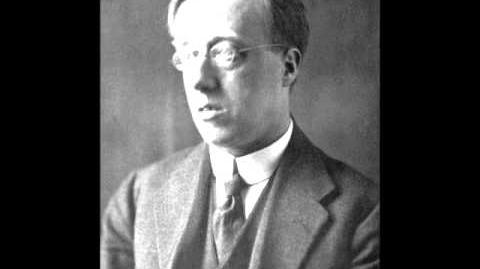
Gustav Holst - The Planets, Op. 32
Holst, The Planets
==Introduction ==
Although Holst originally imagined this work for piano duets and organ (for Neptune alone), Holst found that his most enduring work would best be written for large orchestra.
==Analysis ==
1. Mars, the Bringer of War
This piece is march-like and sounds like an imperial cruiser coming to take over a planet. There is an extensive use of brass and percussive sounds in the strings.
2. Venus, the Bringer of Peace
Begins with a horn motive followed by woodwinds answering. This piece evokes a totally contrasting emotion from the one preceding it. Everything is smooth and flowing.
3. Mercury, the Winged Messenger
Everything about this piece emphasizes quick movement. There is a messenger motive that continues for dozens of measures, passing between voices as if it is being whispered from flute to violin to oboe and onward around the orchestra.
4. Jupiter, the Bringer of Jollity
This piece sounds like a mixture of the Never-Feast from Hook and the Ewok celebration from Return of the Jedi. Holst owes John Williams some royalty checks.
After the introduction, the glorious rich theme (The hymn Thaxted) emerges in chorale form.
5. Saturn, the Bringer of Old Age
There is a grinding, inevitable motion toward nothingness in this piece. Yet despite the gravity of age, there is a glimmer of hope in the coda. This was Holst’s favorite movement, and the perpetual quarter notes that the beginning may have been a nod to his neuritis.
Tells the story of a magician whose apprentice tries to take over, but is thwarted by strong magic. Yes, it is used in Disney’s Fantasia for the Mickey Mouse scene.
This piece is entirely mysterious, and as the closing movement of the work, leaves the audience hoping for more. It ends with a wordless women’s chorus. Much of Vaughan Williams’ work was influenced by Neptune.
==Comparisons ==
The suite is the closest work to impressionism that Holst composed. "Holst sought to convey ideas and emotions associated with the influence of each orbital body on the spyche, which may be why Earth was not included". (Reed) Its strong melodic content mixed with the impressions-based textures have been influential for all film composers since.
Observations[]
Holst ended up hating the work in its entirety because, despite its departure from his typical style of writing, it became hugely famous. After he was known best for his Planets, he wished fame on no one.
Sources:[]
http://isisweb.8m.com/holst/planets.htm#sat
Jeffrey Reed:
http://www.orchestrakentucky.com/planets
Video
https://www.youtube.com/watch?v=AHVsszW7Nds